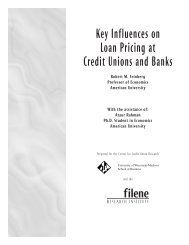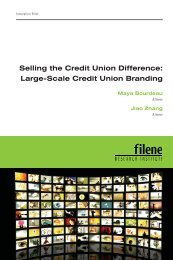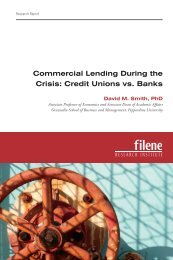Credit Union and Cooperative Patronage Refunds - Filene ...
Credit Union and Cooperative Patronage Refunds - Filene ...
Credit Union and Cooperative Patronage Refunds - Filene ...
Create successful ePaper yourself
Turn your PDF publications into a flip-book with our unique Google optimized e-Paper software.
The subject of this chapter is a theoretical open membership cooperative.<br />
The focus of this report, in fact, is directed at open membership<br />
cooperatives. Open membership means there are no limitations<br />
on the number of members who can join the cooperative or do<br />
business with it. The allocated equity that members earn from doing<br />
business with open membership cooperatives does not appreciate in<br />
value. When allocated equity is redeemed, the co-op pays no more<br />
than the face value of the allocated equity.<br />
In contrast, the common stock in a closed membership cooperative<br />
can appreciate in value if the cooperative is financially successful.<br />
Closed membership cooperatives limit membership because the<br />
co-op’s physical plant size is defined. An ethanol cooperative, for<br />
example, produces a finite number of gallons of ethanol, <strong>and</strong> it needs<br />
a finite number of bushels of corn to produce that ethanol. The<br />
cooperative does not sell more stock or approve new members after<br />
its membership is of sufficient size to produce <strong>and</strong> deliver enough<br />
corn to supply the cooperative’s ethanol production capabilities.<br />
We have already said that a cooperative’s earnings belong to members<br />
rather than the co-op. <strong>Patronage</strong> refunds are distributed from the<br />
co-op’s GAAP patronage- sourced income. Assuming that all earnings<br />
are, in fact, generated from transactions with or for members,<br />
then all of the co-op’s income is theoretically available to allocate to<br />
members on a patronage basis.<br />
Capitalization of the cooperative naturally occurs proportionate to<br />
each member’s use of the cooperative. Earnings are distributed in<br />
cash to the extent possible but are retained by the cooperative as allocated<br />
equity to finance its need for equity capital. The cooperative’s<br />
need for equity turns on its growth objectives, its plans to borrow<br />
debt capital, <strong>and</strong> its desire to redeem equities allocated from previous<br />
years’ earnings. The cooperative aims to generate enough earnings<br />
<strong>and</strong> surplus cash flow to align ownership with use by redeeming the<br />
allocated equity of former, retired, or deceased members.<br />
22








